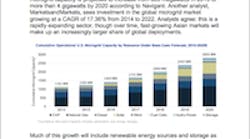The future of microgrids is bright, and increasingly powered by renewable energy. Over the next five years, GTM Research forecasts overall North American microgrid capacity to more than double. Globally, installed microgrid capacity is projected to increase from 685 megawatts in 2013 to more than 4 gigawatts by 2020 according to Navigant. Another analyst, Markets and Markets, sees investment in the global microgrid market growing at a CAGR of 17.36% from 2014 to 2022. Analysts agree: this is a rapidly expanding sector, though over time, fast-growing Asian markets will make up an increasingly larger share of global deployments.
Much of this growth will include renewable energy sources and storage as the costs of both have dropped dramatically in recent years. These factors enhance the economics of high-renewable microgrids while also improving system reliability and flexibility. This can enable both on-grid and off-grid microgrids to support wide-reaching benefits, such as minimizing fuel and net energy costs, deferring system upgrade investments and reducing peak demand or emissions.
Different aspects of microgrids appeal more depending on the application, which in turn is often associated with the region in which the given project is being deployed. In North America, reliability is the driving force, but in Europe microgrids are being tapped to help manage an already high level of renewable energy sources. In developing countries like India, fuel prices
and access to electricity via weak grids is a major issue, but these concerns are also shared by remote industrial operations like mines thatare located far from established power systems.
Today, a range of technologies is making the implementation of microgrids more attractive across a wide variety of applications. From the falling costs of solar power generation and energy storage to advances in control systems, the business case for microgrids is improving by the day.
